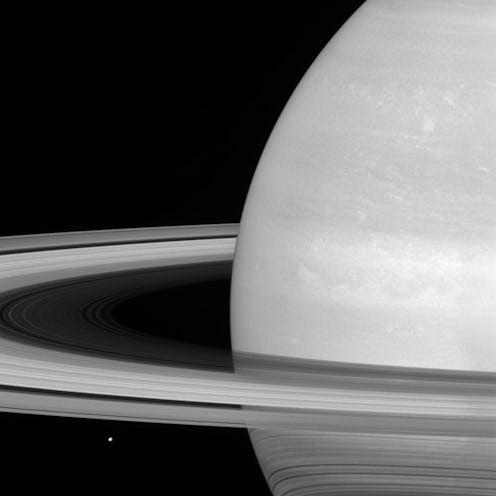Life
Saturn's Rings Are Disappearing Thanks To This Weird Planetary Phenomenon

In case you needed another reason to be sad today, Saturn’s rings are dying and so is the last of my hope. Science will say otherwise but I feel like we are all somehow to blame. The solar system knew we weren’t to be trusted with something so cool and shiny. The universe giveth and the universe taketh away. So, the universe is taketh-ing away our pretty, pretty space rings.
NASA’s Voyager missions in the 1980s captured data suggesting Saturn’s rings were disappearing decades ago. Now, new information is confirming that theory, with NASA predicting the rings will be gone in 100 million years. Of course, we’ll all be long dead by then. (Not to be macabre but you’re not going to live to 100 million years old, sorry.) Also, if we don’t make some major changes. global warming will ruin us all way before then. (Okay, so that one was significantly more macabre but sometimes the truth isn’t cute, friends. Not sorry.)
To us mere, non-scientist mortals, 100 million years may not sound pressing or urgent in any sense of the word. However, NASA scientists are describing the disappearance of Saturn’s rings as a “worst-case-scenario” rate. In other words, it’s bad, y’all.
100 million years is just a fraction of the time Saturn has existed as a planet. So, scientifically speaking, “This is relatively short, compared to Saturn’s age of over 4 billion years,” said James O’Donoghue, post-doctoral fellow at NASA’s Goddard Space Flight Center in Greenbelt, Maryland and lead author of a recent study on Saturn’s ring disappearance.
So, why are the rings disappearing at this alarming rate? Scientists say its due to a process known as “ring rain.” As a video from NASA explains, Saturn’s rings consist of “water ice” which ranges in size from microscopic particles to larger boulders. Ultraviolet light from the sun and plasma clouds from meteoric strikes electrically charge the water ice in the rings. The charged particles then become bound to Saturn’s magnetic field and are pulled into the planet by gravity. This results in particles “raining” down into the planet. According to recent reports, this process drains enough water that you could “fill an Olympic-sized swimming pool from Saturn’s rings in half an hour.” In other words, it's a lot of ring rain.
“From this alone, the entire ring system will be gone in 300 million years, but add to this the Cassini-spacecraft measured ring-material detected falling into Saturn’s equator, and the rings have less than 100 million years to live,” O’Donoghue said. O’Donoghue is referring to when NASA's Cassini spacecraft was sent into the planet in 2017. The spacecraft detected ring particles falling into Saturn’s atmosphere at the equator. These ring fragments were also falling out “faster than scientists thought.” This paired with the report confirms that Saturn’s rings are dying at a rapid rate.
While Saturn’s had rings as long as humans have studied space, the planet hasn’t always had its seemingly iconic ring. Scientists estimate Saturn has only had rings for about 100 million years. Meaning, we’re catching the rings at the midway point of their existence. Put into context, Saturn has spent about 98 percent of its life without its rings.
“We are lucky to be around to see Saturn's ring system,” said O'Donoghue. Take a moment to revel in the beauty of that statement before your world comes crashing down once again. O'Donoghue also noted that “perhaps we just missed out on seeing giant ring systems of Jupiter, Uranus, and Neptune, which have only thin ringlets today.”
BRB crying at the loss of planetary rings we never knew.